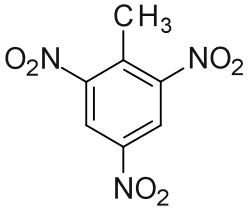Trinitrotoluene
impact-resistant high explosive From Wikipedia, the free encyclopedia
Remove ads
Trinitrotoluene (abbreviated TNT) (/ˌtraɪˌnaɪtroʊˈtɒljuiːn/) more specifically 2,4,6-trinitrotoluene, is a powerful nitroaromatic explosive, occasionally used as a reagent in chemical synthesis.

History
TNT was first made in 1863 by Julius Wilbrand[1] and originally used as a yellow dye. It was not recognized as an explosive for 28 years, until the chemist Carl Häussermann discovered its explosive properties in 1891.[2]

The German military started filling artillery shells with TNT 1902. TNT-filled shells would explode after they had broken through the armour of ships, whereas the British Lyddite (Picric acid)-filled shells exploded when they hit the armour, wasting energy outside the ship.[3] The British started replacing Pciric acid with TNT in 1907.[4]
Remove ads
Uses
TNT is one of the world's most commonly used explosives, in the military, mining, and industrial operations.
TNT is often blended with other explosives to get desired properties.[source?]
References
Wikiwand - on
Seamless Wikipedia browsing. On steroids.
Remove ads
